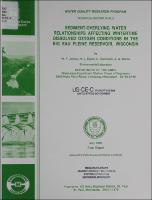Please use this identifier to cite or link to this item:
https://hdl.handle.net/11681/4365| Title: | Sediment-overlying water relationships affecting wintertime dissolved oxygen conditions in the Big Eau Pleine Reservoir, Wisconsin |
| Authors: | United States. Army. Corps of Engineers. St. Paul District Water Quality Research Program (U.S.) James, William F., Aquatic biologist Eakin, Harry L. Gunnison, Douglas Barko, John W. |
| Keywords: | Ammonium BOD COD Dissolved organic carbon Fish kill Hypolimnion Interstitial Iron Manganese Oxygen sag Phosphate Sediment oxygen demand Water quality Reservoirs Big Eau Pleine Reservoir Wisconsin |
| Publisher: | Environmental Laboratory (U.S.) Engineer Research and Development Center (U.S.) |
| Description: | Technical Report Abstract: Effects of sediment disturbance and associated chemical oxygen demand on dissolved oxygen (DO) depletion were evaluated during the winters of 1989-1990 in the Big Eau Pleine Reservoir. As part of this effort, historical DO data, sediment physical and chemical composition, net sedimentation rates, and water quality characteristics were examined. DO depletion and anoxia in the winter develop rapidly in the headwaters in association with drawdown conditions and low inflows from the Big Eau Pleine River. DO depletion also occurs near the dam of the reservoir. Entrainment of anoxic water from the headwaters and its downstream movement during the winter are promoted by continued withdrawal from the reservoir. Three distinct zones of sedimentation (erosional, accumulation, and transport zones) were identified, based on the moisture content of the surficial sediment. Sediments in the erosional zone occupied 60 percent of the reservoir surface area and exhibited low moisture content, high sediment density, and low net sedimentation rates. Physical composition of erosional zone sediments varied greatly at different times of the year, indicating deposition, disturbance and/or resuspension, and removal of sediment. The erosional zone was within the region of average winter drawdown (1,128 ft MSL). This suggested that winter drawdown may be an important factor in sediment disturbance and longitudinal transport toward the dam. The accumulation zone was located in the basin near the dam and occupied only 2 percent of the reservoir surface area. Sediments in this zone exhibited a higher moisture content, lower sediment density, and higher net sedimentation rate, indicating sediment focusing. Sediment displacement from the erosional zone to the accumulation zone appeared to influence oxygen dynamics in the reservoir. In contrast, sediment in the transport zone, intermediate to the other two zones, was not found to be of critical importance for reservoir oxygen dynamics during this study. Concentrations of soluble iron, manganese, organic carbon, and chemical oxygen demand (COD) in the interstitial water of the surficial sediments were found to be moderately high and have the potential to exert a substantial COD to the overlying water column during winter drawdown and sediment disturbance. In addition, decreases in the mass of oxygen stores and increases in the reservoir surface to volume ratio during the drawdown favor more rapid development of anoxic conditions, particularly in the headwaters, thus contributing to the further decline in DO levels. The results of these studies were used to critically evaluate previous recommendations for managing the reservoir. This evaluation suggests that maintaining a higher pool elevation during the winter months may significantly improve DO conditions in the reservoir. Aeration systems do not appear effective in maintaining high DO levels in the water column when anoxic waters containing high levels of soluble metals and COD move into the region of reaeration. Thus, if a higher pool elevation can not be maintained, it is likely that additional aerators must be installed for incremental use to meet periodic heavy oxygen demands. |
| Rights: | Approved for public release; distribution is unlimited. |
| URI: | http://hdl.handle.net/11681/4365 |
| Appears in Collections: | Technical Report |
Files in This Item:
| File | Description | Size | Format | |
|---|---|---|---|---|
| TR-W-92-2.pdf | 15.34 MB | Adobe PDF |  View/Open |